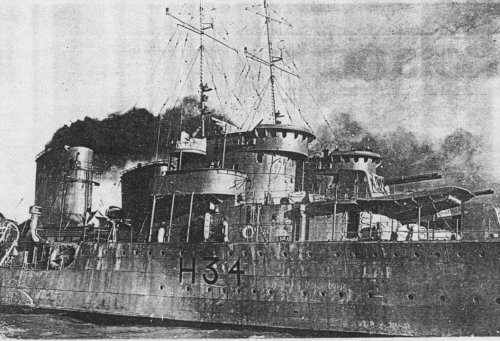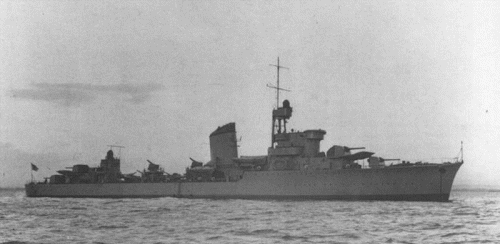
NAVYPEDIA
 Support the project with paypal
Support the project with paypal
Photo

Błyskawica and Grom 1939
Ships
| Name | No | Yard No | Builder | Laid down | Launched | Comp | Fate |
|---|---|---|---|---|---|---|---|
| Błyskawica | N51, 51, 1960- 271 | 1801 | White, Cowes, UK | 11.1935 | 1.10.1936 | 11.1937 | guard ship 1960, preserved 5.1976 |
| Grom | 1800 | White, Cowes, UK | 7.1935 | 20.7.1936 | 5.1937 | sunk 4.5.1940 |
Technical data
| Displacement standard, t | 1975 |
|---|---|
| Displacement full, t | 2383 |
| Length, m | 109.0 pp 114.0 oa |
| Breadth, m | 11.3 |
| Draught, m | 3.50 mean |
| No of shafts | 2 |
| Machinery | 2 sets Parsons geared steam turbines, 4 (3 main + 1 auxiliary) 3-drum boilers |
| Power, h. p. | 54000 |
| Max speed, kts | 39 |
| Fuel, t | oil 350 |
| Endurance, nm(kts) | 3500(15) |
| Armament | 3 x 2 - 120/50 Bofors M34/36, 1 x 1 - 120/50 Bofors M34/36, 2 x 2 - 40/56 Bofors M/36, 4 x 2 - 13.2/76, 2 x 3 - 533 TT (can use also 450mm torpedoes), 44 mines, 2 DCR (40) |
| Electronic equipment | hydrophone |
| Complement | 190 - 200 |
Standard scale images

Błyskawica 1942

Błyskawica 1945

Błyskawica 1960

Grom 1940

Błyskawica 1942

Grom 1939
Graphics
Project history
Built within limits of the 6-year programme accepted in 1936 (though destroyers were ordered before the formal programme approving, 29.3.1935). They were built in UK under the original design, instead of earlier Wicher class, built under modified already existing one.
As Poland could not rival to the neighbours in number of built ships, at preparing of requirements for new destroyers the way of the individual superiority over destroyers of German and Soviet navies has been chosen. As a result designed by designers of "White", Błyskawica and Grom appeared the strongest European destroyers of time, yielding only to last French leaders (objectively speaking, to the intermediate ships between cruisers and destroyers).
Presence of two twin 40mm Bofors MGs deduced these ships on the first place on AA armament: in 1937, when they were commissioned, any destroyer in the world could not rival with Błyskawica and Grom on this indicator.
Torpedo armament was British, and TTs had possibility to launch both 533mm and 457mm torpedoes. British Mk X torpedoes with which the Polish ships were completed, had one serious lack: badly thought over block system of fuses. In judgement of British experts, it served as a cause of loss of Grom.
The 1936 programme provided building of two more ships of this class. For development of domestic industry it has been decided to build them at Gdynia. The order on Huragan and Orkan was given out 1.5.1939, but prior to the beginning of war only part of materials was prepared, and works never reached laying down stage.
After passage of ships to Britain in 1939 they were transferred under control of Admiralty. The stability of Błyskawica and Grom not to the full corresponded to RN standards, therefore in the winter 1939/40 they passed the modernization directed on decrease of the top weight: projector top on foremast, aft projector post, funnel cap were removed, the number of lifeboats was decreased.
In December, 1941 Błyskawica was re-armed: 120mm Bofors guns were replaced by 102mm twin Mk XVI guns in Mk XIX DP mounts. First of all, similar replacement spoke desire of British to be saved from "non-standard" ammunition of foreign production which besides has appeared in practice inconvenient enough (fixed round weighed almost 41kg). Replacement of main guns by DPs demanded replacement of fire control system.
Modernizations
early 1940, both: - 1 x 3 - 533 TT; + 1 x 1 - 102/45 QF Mk V
12/1941, Błyskawica: - 3 x 2 - 120/50, 1 x 1 - 120/50, 1 x 1 - 102/45, 4 x 2 - 13.2/76; + 4 x 2 - 102/45 QF Mk XVI, 4 x 1 - 20/70 Oerlikon Mk II/IV, 1 x 3 - 533 TT, 2 DCT, type 272, type 291 radars, type 128 sonar
mid-1942, Błyskawica: - 2 x 3 - 533 TT; + 1 x 4 - 533 TT, 2 DCT (full Dp was 2440t)
1944, Błyskawica: - type 272 radar; + type 271, type 293 radars.
(10/1949 - 4.1950), Błyskawica: was fully rearmed with 4 x 1 - 100/56 B-34-USM, 4 x 2 - 37/70 V-11, 2 x 1 - 37/73 70K, 1 x 5 - 533 TT, 4 DCT, 2 DCR, Rif-1, Giuys-1B, Rym-1 radars, Tamir-5N sonar (displacement was 1975/2183t)
Naval service
Błyskawica and Grom 30.8.1939 left to Britain in an operation "Beijing". Grom was sunk by German aircraft at coast of Norway 4.5.1940. Two bombs hit the ship, one of which called explosion of torpedoes in TT, ship was broken apart and sunk.
After war, in 1947, Błyskawica returned to Poland, since 1.5.1976 she was preserved at Gdynia as memorial, replacing Burza in this quality.
 HOME
HOME FIGHTING SHIPS OF THE WORLD
FIGHTING SHIPS OF THE WORLD POLAND
POLAND TORPEDO SHIPS
TORPEDO SHIPS GROM destroyers (1937)
GROM destroyers (1937)


